Optimization of Contact Pad Design for Silver Nanowire-Based Transparent Heater to Improve Heating Characteristics
Abstract
1. Introduction
2. Materials and Methods
3. Results and Discussion
3.1. Optimizing Electrode Shape of Transparent Heater Through Heating Characteristics
3.2. Heating Characteristics of Transparent Heater by Adjusting Size of Parallel Shape
3.3. Optical Properties of Transparent Heaters Depending on Size of Parallel Shape
4. Conclusions
Supplementary Materials
Author Contributions
Funding
Data Availability Statement
Conflicts of Interest
References
- Rao, K.; Kulkarni, G. A highly crystalline single Au wire network as a high temperature transparent heater. Nanoscale 2014, 6, 5645–5651. [Google Scholar] [CrossRef] [PubMed]
- Chevallier, P.; Turgeon, S.; Sarra-Bournet, C.; Turcotte, R.; Laroche, G. Characterization of Multilayer Anti-Fog Coating. ACS Appl. Mater. Interfaces 2011, 3, 750–758. [Google Scholar] [CrossRef]
- Veeramuthu, L.; Chen, B.; Rsai, C.; Liang, F.; Venkatesan, M.; Jiang, D.; Chen, C.; Cai, X.; Kuo, C. Novel stretchable thermo-chromic transparent heaters designed for smart window defroster application by spray coating silver nanowire. RSC Adv. 2019, 9, 35786–35796. [Google Scholar] [CrossRef]
- Hu, Y.; Zhang, Z.; Zhang, D.; Xiu, F.; Zhang, M.; Song, X.; Song, C.; Zhang, Z.; Chen, C.; Xie, X.; et al. Adaptive and Remote Thermoregulation Enable with a Highly Stable Transparent Flexible Heating Film. ACS Appl. Energy Mater. 2022, 5, 8892–8899. [Google Scholar] [CrossRef]
- Lee, D.; Bang, G.; Byun, M.; Choi, D. Highly flexible, transparent and conductive ultrathin silver film heaters for wearable electronics applications. Thin Solid Film. 2020, 3, 137835. [Google Scholar] [CrossRef]
- Grangvist, C. Electrochromics and Thermochromics: Towards a new paradigm for energy efficient buildings. Mater. Today Proc. 2016, 3, 2–11. [Google Scholar] [CrossRef]
- Gaynor, W.; Hofmann, S.; Christforo, M.; Saches, C.; Mehra, S.; Salleo, A.; Mcgehhe, M.; Gather, M.; Lussem, B.; Muller, L.; et al. Color in the corners: ITO-free white OLEDs with angular color stability. Adv. Mater. 2013, 25, 4006–4013. [Google Scholar] [CrossRef]
- Granqvist, C. Transparent conductors as solar energy materials: A panoramic review. Sol. Energy Mater Sol. Cells 2007, 91, 1529–1598. [Google Scholar]
- Papanastasiou, D.; Schultheiss, A.; Munoz, D.; Celle, C.; Carella, A.; Simonato, J.; Bellet, D. Transparent heaters: A review. Adv. Funct. Mater. 2020, 30, 1910225. [Google Scholar] [CrossRef]
- Gupta, R.; Rao, K.; Kirunthika, S.; Kulkarni, G. Visibly Transparent Heaters. ACS Appl. Mater. Interfaces 2016, 8, 12559–12575. [Google Scholar] [CrossRef]
- Ko, E.; Kim, H.; Lee, S.; Lee, J.; Kim, H. Nano-sized Ag inserted into ITO films prepared by continuous roll-to-roll sputtering for high-performance, flexible, transparent film heaters. RSC Adv. 2016, 6, 46634–46642. [Google Scholar] [CrossRef]
- Park, S.; Lee, S.; Ko, E.; Kim, T.; Nah, Y.; Lee, S.; Lee, J.; Kim, H. Roll-to-Roll sputtered ITO/Cu/ITO multilayer electrode for flexible, transparent thin film heaters and electrochromic applications. Sci. Rep. 2016, 6, 33868. [Google Scholar] [CrossRef] [PubMed]
- Jeong, S.; Ham, S.; Choi, E.; Hwang, D.; Yu, H.; Kim, W.; Kim, G.; Jeong, J. Enhanced Mechanical Stability of CIGS Solar Module with Glass/Polyimide/Indium Tin Oxide for Potentially Flexible Applications. ACS Appl. Energy Mater. 2023, 6, 3745–3755. [Google Scholar] [CrossRef]
- Khairnarm, N.; Kwon, H.; Park, S.; Lee, H.; Park, J. Tailoring the Size and Shape of ZnO Nanoparticles for Enhanced Performace of OLED Device. Nanomaterials 2023, 13, 2816. [Google Scholar]
- Leung, W.; Chan, Y.; Lui, S. A study of degradation of indium tin oxide thin films on glass for display applications. Microelectron Eng. 2013, 101, 1–7. [Google Scholar] [CrossRef]
- Ahmad, K.; Song, G.; Kim, H. Fabrication of Tungsten Oxide/Graphene Quantum Dot (WO3@GQD) Thin Films on Indium Tin Oxide-Based Glass and Flexible Substrates for the Construction of Electrochromic Devices for Smart Window Applications. ACS Sustain. Chem. Eng. 2022, 10, 11948–11957. [Google Scholar] [CrossRef]
- Wu, C. Highly flexible touch screen panel fabricated with silver-inserted transparent ITO triple-layer structures. RSC Adv. 2018, 8, 11862–11870. [Google Scholar] [CrossRef]
- Krantz, J.; Richter, M.; Spallek, S.; Spiecker, E.; Brabec, C. Solution-Processed Metallic Nanowire Electrodes as Indium Tin Oxide Replacement for Thin-Film Solar Cells. Adv. Funct. Mater. 2011, 21, 4784–4787. [Google Scholar] [CrossRef]
- Sears, K.; Fanchini, G.; Watkins, S.; Huynh, C.; Hawkins, S. Aligned carbon nanotube webs as a replacement for indium tin oxide in organic solar cells. Thin Solid Film. 2013, 3, 525–529. [Google Scholar] [CrossRef]
- Yan, H.; Jo, T.; Okuzaki, H. Potential application of highly conductive and transparent poly(3,4-ethylenedioxythiophene)/poly(4-styrenesulfonate) thin films to touch screen as a replacement for indium tin oxide electrode. Polym J. 2011, 43, 662–665. [Google Scholar] [CrossRef]
- Varela-Rizo, H.; Martín-Gullón, I.; Terrones, M. Hybrid Films with Graphene Oxide and Metal Nanoparticles Could Now Replace Indium Tin Oxide. ACS Nano. 2012, 6, 4565–4572. [Google Scholar] [CrossRef] [PubMed]
- Weng, Z.; Dixon, S.; Lee, L.; Humphreys, C.; Guiney, I.; Fenwick, O.; Gillin, W. Wafer-Scale Graphene Anodes Replace Indium Tin Oxide in Organic Light-Emitting Diodes. Adv. Opt. Mater. 2022, 10, 101675. [Google Scholar] [CrossRef]
- Ko, D.; Gu, B.; Kang, S.J.; Jo, S.; Hyun, D.C.; Kim, C.S.; Kim, J. Critical work of adhesion for economical patterning of silver nanowire-based transparent electrodes. J. Mater. Chem. A 2019, 7, 14536–14544. [Google Scholar] [CrossRef]
- Sim, H.; Kim, C.; Bok, S.; Kim, M.K.; Oh, H.; Lim, G.; Cho, S.M.; Lim, B. Five-minute synthesis of silver nanowires and their roll-to-roll processing for large-area organic light emitting diodes. Nanoscale 2018, 10, 12087–12092. [Google Scholar] [CrossRef]
- Jang, J.; Hyun, B.G.; Ji, S.; Cho, E.; An, B.W.; Cheong, W.H.; Park, J.-U. Rapid production of large-area, transparent and stretchable electrodes using metal nanofibers as wirelessly operated wearable heaters. NPG Asia Mater. 2017, 9, e432. [Google Scholar] [CrossRef]
- Shen, C.; Ye, J.; Peserico, N.; Gui, Y.; Dong, C.; Kang, H.; Nouri, B.M.; Wang, H.; Heidari, E.; Sorger, V.J.; et al. Enhancing Focusing and Defocusing Capabilities with a Dynamically Reconfigurable Metalens Utilizing Sb2Se3 Phase-Change Material. Nanomaterials 2023, 13, 2106. [Google Scholar] [CrossRef]
- Hwang, I.; Seong, M.; Yi, H.; Ko, H.; Park, H.-H.; Yeo, J.; Bae, W.-G.; Park, H.W.; Jeong, H.E. Low-Resistant Electrical and Robust Mechanical Contacts of Self-Attachable Flexible Transparent Electrodes with Patternable Circuits. Adv. Func. Mater. 2020, 30, 2000458. [Google Scholar] [CrossRef]
- Patel, M.; Seo, J.H.; Kim, S.; Nguyen, T.T.; Kumar, M.; Yun, J.; Kim, J. Photovoltaic-driven transparent heater of ZnO-coated silver nanowire networks for self-functional remote power system. J. Power Sour. 2021, 491, 229578. [Google Scholar] [CrossRef]
- Patel, M.; Seo, J.H.; Nguyen, T.T.; Kim, J. Active energy-controlling windows incorporating transparent photovoltaics and an integrated transparent heater. Cell Rep. Phys. Sci. 2021, 2, 100591. [Google Scholar] [CrossRef]
- Patel, M.; Kim, S.; Kim, J. Field-Induced Transparent Electrode-Integrated Transparent Solar Cells and Heater for Active Energy Windows: Broadband Energy Harvester. Adv. Sci. 2023, 10, 2303895. [Google Scholar] [CrossRef]
- Feng, Y.; Song, J.; Han, G.; Zhou, B.; Liu, C.; Shen, C. Transparent and Stretchable Electromagnetic Interference Shielding Film with Fence-like Aligned Silver Nanowire Conductive Network. Small Methods 2023, 7, 2201490. [Google Scholar] [CrossRef] [PubMed]
- Xu, R.; Sun, B.; Han, X.; Hong, W.; Xu, J.; Zhu, H.; Fu, Z.; Xu, Y.; Sun, X.; Qian, K. High-Performance Flexible Transparent Electrical Heater Based on a Robust Ordered Ag Nanowire Micromesh Conductor. ACS Appl. Electron. Mater. 2022, 4, 1776–1783. [Google Scholar] [CrossRef]
- Kumar, D.V.R.; Koshy, A.M.; Sharma, N.; Thomas, N.; Swaminathan, P. Room Temperature Curable Copper Nan-owire-Based Transparent Heater. ACS Omega 2023, 8, 21107–21112. [Google Scholar] [CrossRef] [PubMed]
- Lan, W.; Chen, Y.; Yang, Z.; Han, W.; Zhou, J.; Zhang, Y.; Wang, J.; Tang, G.; Wei, Y.; Dou, W.; et al. Ultraflexible Transparent Film Heater Made of Ag Nanowire/PVA Composite for Rapid-Response Thermotherapy Pads. ACS Appl. Mater. Interfaces 2017, 9, 6644–06651. [Google Scholar] [CrossRef]
- Xia, Z.; Zhang, T.; Tian, L.; Tian, B.; Ni, J.; Hou, F.; Li, T. Flexible MXene Hybrid Films with a Tuned Silver Nanowire Framework for Electromagnetic Interference Shielding and Ultralow Voltage-Driven Joule Heating. ACS Appl. Nano Mater. 2024, 7, 3748–3760. [Google Scholar] [CrossRef]
- Lagrange, M.; Langley, D.P.; Giusti, G.; Jiménez, C.; Bréchet, Y.; Bellet, D. Optimization of silver nanowire-based transpar-ent electrodes: Effects of density, size and thermal annealing. Nanoscale 2015, 7, 17410–17423. [Google Scholar] [CrossRef]
- Ko, D.; Gu, B.; Cheon, J.; Roh, J.-S.; Kim, C.S.; Jo, S.; Hyun, D.C.; Kim, J. Decoupling the contributions to the enhancement of electrical conductivity in transparent silver nanowire/zinc oxide composite electrodes. Mater. Chem. Phys. 2019, 223, 634–640. [Google Scholar] [CrossRef]
- Lee, S.; Kim, D.-I.; Kim, Y.-Y.; Park, S.-E.; Choi, G.; Kim, Y.; Kim, H.-J. Droplet evaporation characteristics on transparent heaters with different wettabilities. RSC Adv. 2017, 7, 45274. [Google Scholar] [CrossRef]
- Sharma, V.; Koivikko, A.; Yiannacou, K.; Lahtonen, K.; Sariola, V. Flexible biodegradable transparent heaters based on fractal-like leaf skeletons. npj Flex. Electron. 2020, 4, 27. [Google Scholar] [CrossRef]

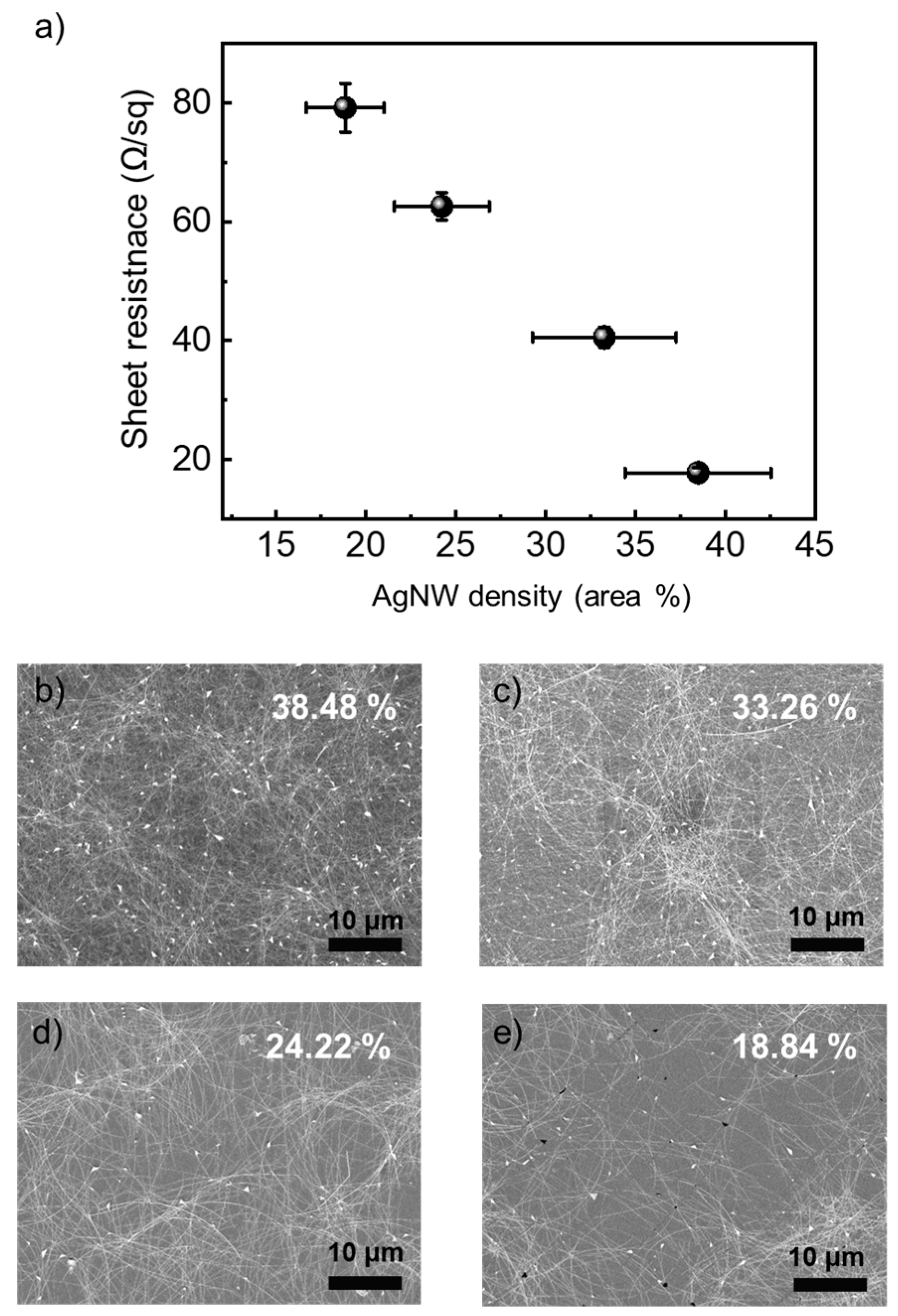
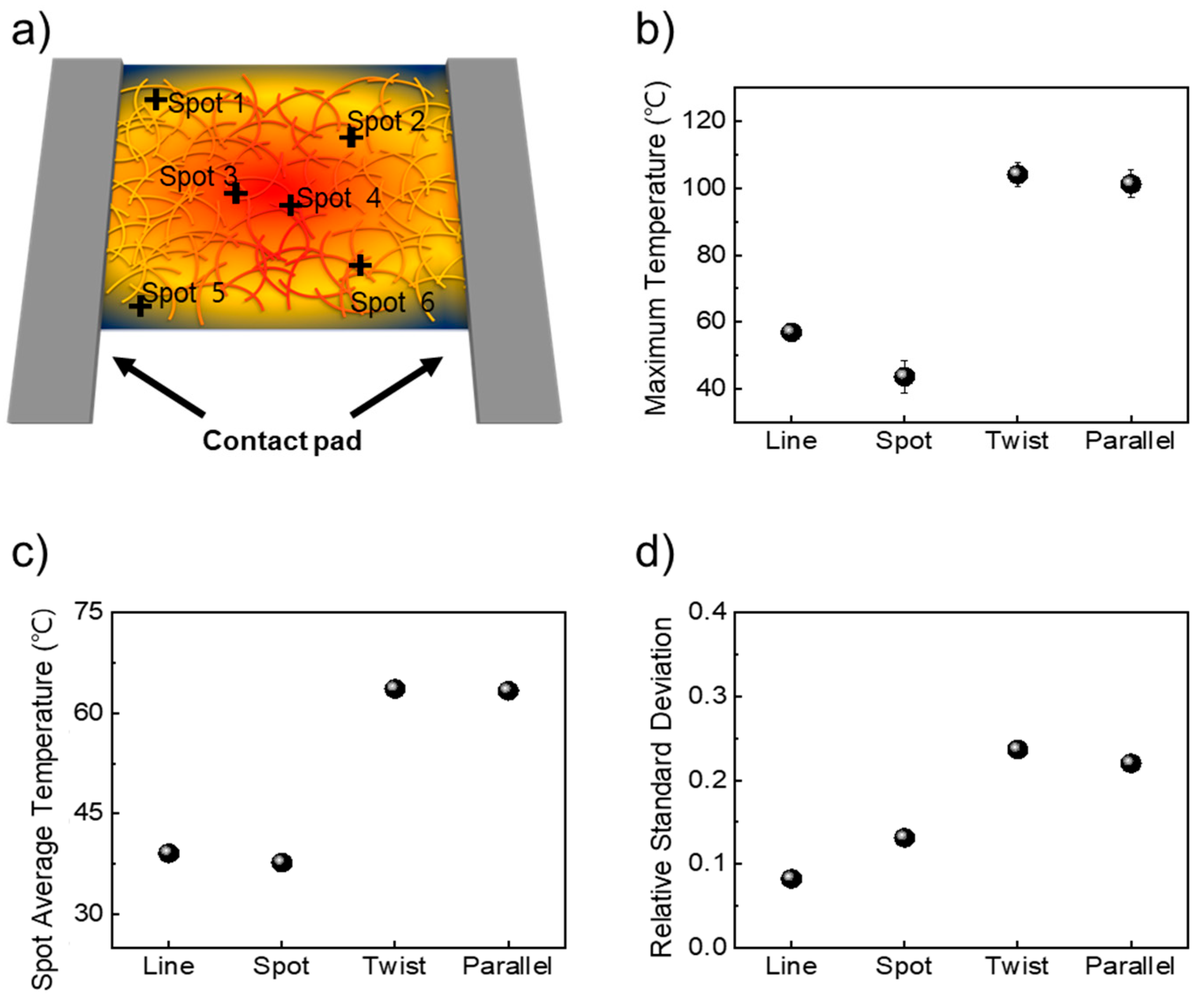
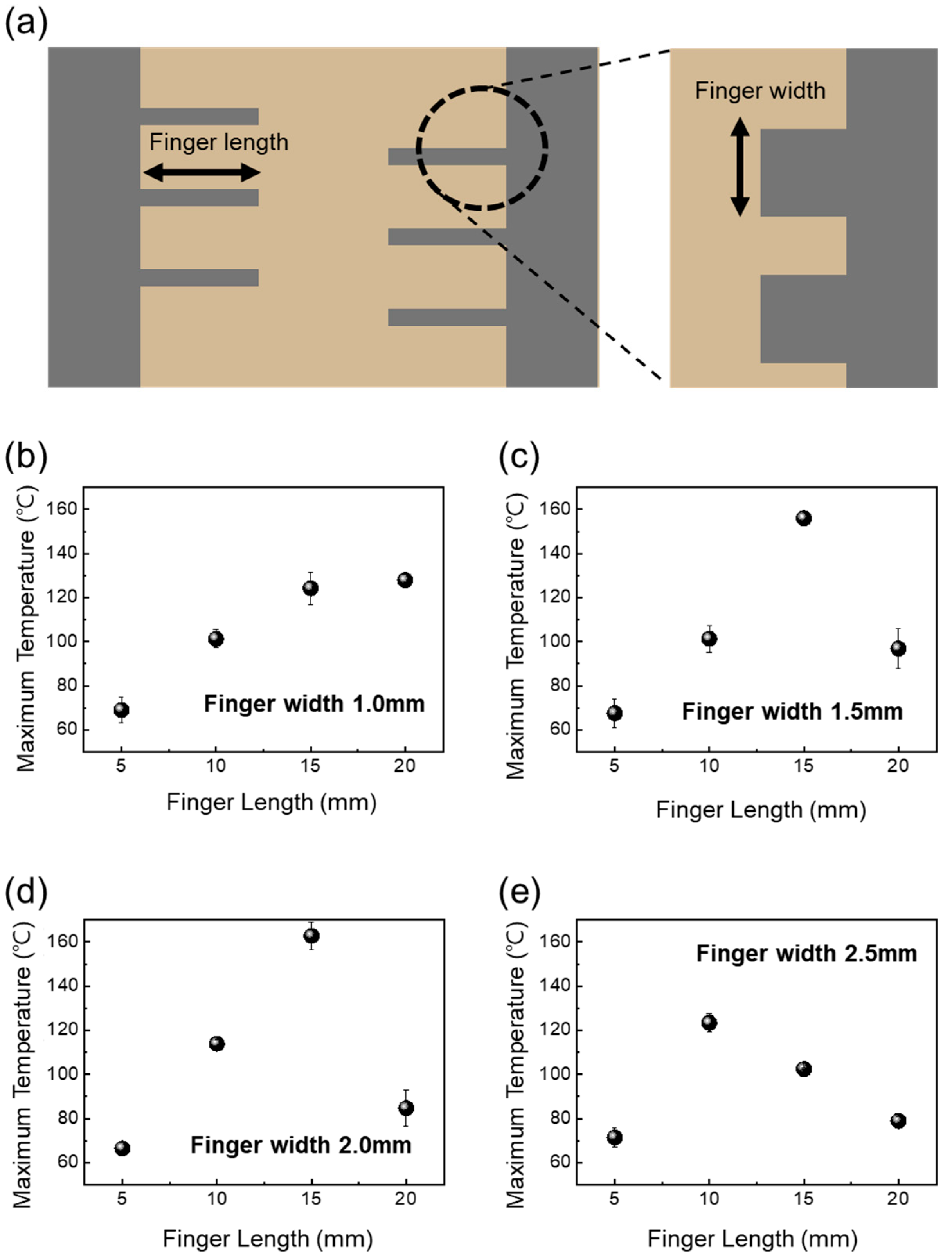
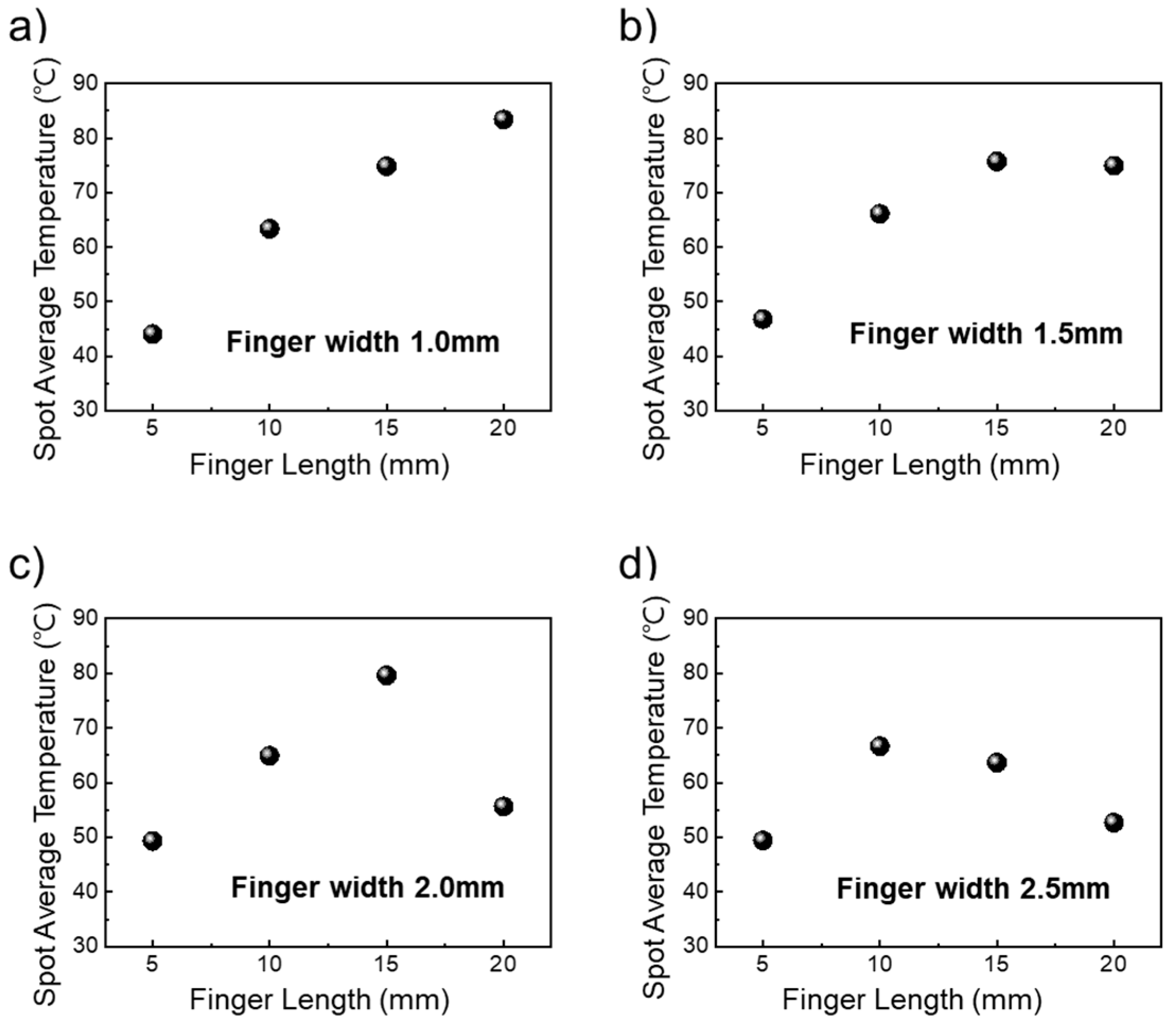
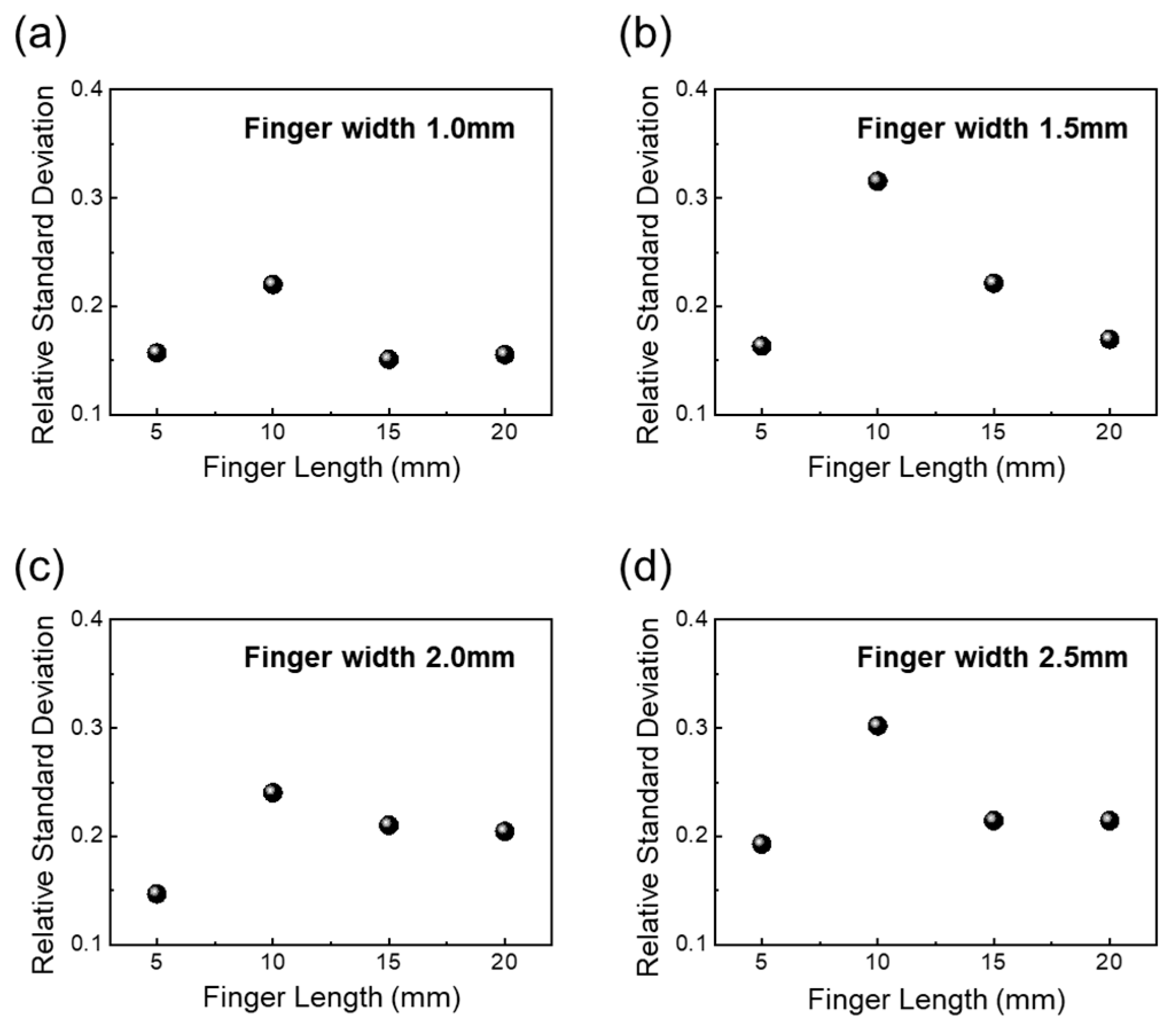
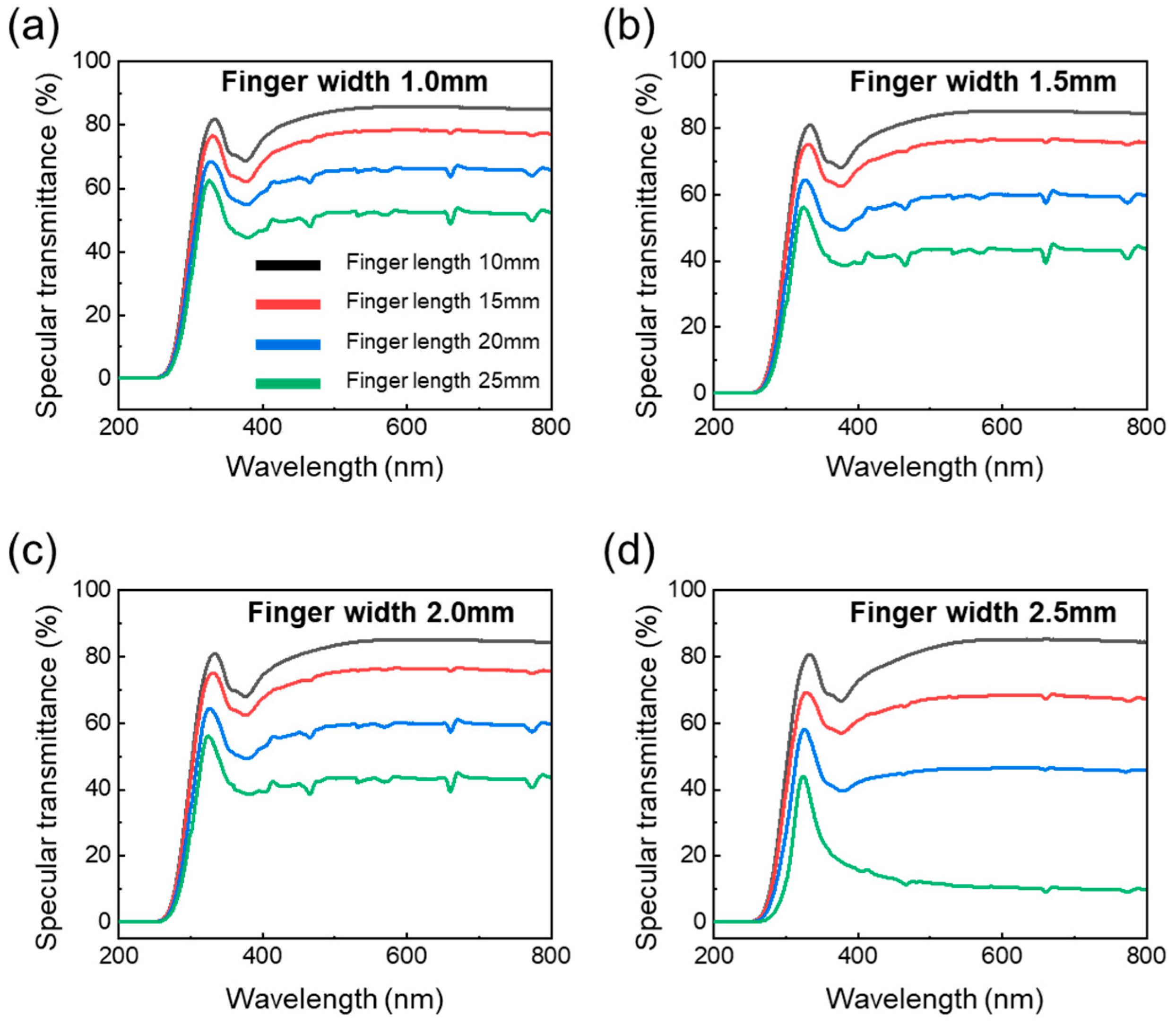
Disclaimer/Publisher’s Note: The statements, opinions and data contained in all publications are solely those of the individual author(s) and contributor(s) and not of MDPI and/or the editor(s). MDPI and/or the editor(s) disclaim responsibility for any injury to people or property resulting from any ideas, methods, instructions or products referred to in the content. |
© 2024 by the authors. Licensee MDPI, Basel, Switzerland. This article is an open access article distributed under the terms and conditions of the Creative Commons Attribution (CC BY) license (https://creativecommons.org/licenses/by/4.0/).
Share and Cite
Chu, S.B.; Ma, Y.; Jung, J.; Jo, S.; Hyun, D.C.; Roh, J.-S.; Kim, J.; Ko, D. Optimization of Contact Pad Design for Silver Nanowire-Based Transparent Heater to Improve Heating Characteristics. Nanomaterials 2024, 14, 1735. https://doi.org/10.3390/nano14211735
Chu SB, Ma Y, Jung J, Jo S, Hyun DC, Roh J-S, Kim J, Ko D. Optimization of Contact Pad Design for Silver Nanowire-Based Transparent Heater to Improve Heating Characteristics. Nanomaterials. 2024; 14(21):1735. https://doi.org/10.3390/nano14211735
Chicago/Turabian StyleChu, Seo Bum, Yoohan Ma, Jinwook Jung, Sungjin Jo, Dong Choon Hyun, Jae-Seung Roh, Jongbok Kim, and Dongwook Ko. 2024. "Optimization of Contact Pad Design for Silver Nanowire-Based Transparent Heater to Improve Heating Characteristics" Nanomaterials 14, no. 21: 1735. https://doi.org/10.3390/nano14211735
APA StyleChu, S. B., Ma, Y., Jung, J., Jo, S., Hyun, D. C., Roh, J.-S., Kim, J., & Ko, D. (2024). Optimization of Contact Pad Design for Silver Nanowire-Based Transparent Heater to Improve Heating Characteristics. Nanomaterials, 14(21), 1735. https://doi.org/10.3390/nano14211735






